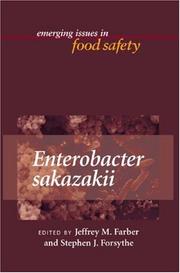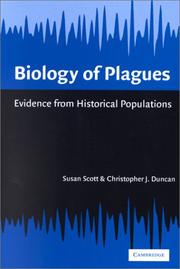| Listing 1 - 10 of 16 | << page >> |
Sort by
|
Dissertation
Abstract | Keywords | Export | Availability | Bookmark
 Loading...
Loading...Choose an application
- Reference Manager
- EndNote
- RefWorks (Direct export to RefWorks)
Enterobacteriaceae infections --- enzymology --- epidemiology
Dissertation
Year: 1988 Publisher: Liège : Université de Liège. Faculté de médecine (ULg). Département de clinique et pathologie médicales,
Abstract | Keywords | Export | Availability | Bookmark
 Loading...
Loading...Choose an application
- Reference Manager
- EndNote
- RefWorks (Direct export to RefWorks)
Book
Year: 1972 Volume: 500 Publisher: Geneva : World Health Organization,
Abstract | Keywords | Export | Availability | Bookmark
 Loading...
Loading...Choose an application
- Reference Manager
- EndNote
- RefWorks (Direct export to RefWorks)
Enterobacteriaceae Infections --- Intestinal Diseases --- Vaccines. --- Enteritis --- prevention & control.
Dissertation
Year: 1997 Publisher: Liège : Université de Liège. Faculté de médecine (ULg). Département de clinique et pathologie médicales,
Abstract | Keywords | Export | Availability | Bookmark
 Loading...
Loading...Choose an application
- Reference Manager
- EndNote
- RefWorks (Direct export to RefWorks)
CROSS INFECTION --- ENTEROBACTER --- ENTEROBACTERIACEAE INFECTIONS --- INTENSIVE CARE UNITS --- BELGIUM --- EPIDEMIOLOGY

ISBN: 1555814603 9781555814601 9781683671541 1683671546 9781555815608 155581560X 1283033909 9786613033901 Year: 2008 Publisher: Washington, D.C. : ASM Press,
Abstract | Keywords | Export | Availability | Bookmark
 Loading...
Loading...Choose an application
- Reference Manager
- EndNote
- RefWorks (Direct export to RefWorks)
This volume brings together all recent findings and knowledge on this unique pathogen and addresses a wide range of issues, including taxonomy, detection and identification, virulence potential, monitoring and control during infant formula production, and regulatory issues.
Agrotechnology and Food Sciences. Food Sciences --- Enterobacter sakazakii --- Enterobacter sakazakii. --- Enterobacteriaceae Infections --- Food Contamination --- Infant Formula --- Infant formulas --- Food Microbiology. --- pathogenicity. --- prevention & control. --- standards. --- Contamination. --- Food contamination --- Enterobacter
Book
ISBN: 2130741371 9782130747055 2130747051 9782130741374 Year: 2010 Publisher: Paris (6, avenue Reille 75685) : P.U.F.,
Abstract | Keywords | Export | Availability | Bookmark
 Loading...
Loading...Choose an application
- Reference Manager
- EndNote
- RefWorks (Direct export to RefWorks)
La peste a été l'une des plus effrayantes maladies infectieuses de l'histoire. Ses principaux acteurs en sont le bacille de la peste, le rat et la puce du rat. L'évolution de la maladie au fil du temps tient à la variabilité de ces acteurs : diffusion du rat noir, puis son remplacement par le surmulot, mutations du bacille de Yersin. L'homme n'en a été que l'hôte accidentel… Et pourtant, les conséquences démographiques et économiques des pandémies de peste (depuis la peste de Justinien jusqu'à la Peste noire du Moyen Âge et celle, mondiale, des années 1880-1920) ont été si importantes en Europe, en Asie et dans le monde musulman, qu'elles ont entraîné une modification profonde des mentalités religieuses, des craintes eschatologiques et apocalyptiques. La peste noire est à l'origine de la quarantaine, de l'apparition des flagellants, de l'épidémie de sorcellerie des Temps modernes et, au moins en partie, de la Réforme. La peste aura ainsi marqué profondément le langage, la littérature classique et moderne, et l'art religieux puis profane.
Plague --- Epidemics --- Yersinia Infections --- Enterobacteriaceae Infections --- Gram-Negative Bacterial Infections --- Bacterial Infections --- Bacterial Infections and Mycoses --- Diseases --- Infectious Diseases --- Medicine --- Health & Biological Sciences --- History
Book
ISBN: 158836285X 1299179894 Year: 2003 Publisher: New York : Random House,
Abstract | Keywords | Export | Availability | Bookmark
 Loading...
Loading...Choose an application
- Reference Manager
- EndNote
- RefWorks (Direct export to RefWorks)
Plague --- Plague --- Yersinia Infections --- Public Health --- History, Modern 1601 --- -History --- Enterobacteriaceae Infections --- Environment and Public Health --- Humanities --- Delivery of Health Care. --- Gram-Negative Bacterial Infections --- Bacterial Infections --- Bacterial Infections and Mycoses --- Disease. --- Plague --- History, 20th Century --- Disease Outbreaks --- History --- history --- California
Book
ISBN: 0752496530 Year: 2013 Publisher: New York : The History Press,
Abstract | Keywords | Export | Availability | Bookmark
 Loading...
Loading...Choose an application
- Reference Manager
- EndNote
- RefWorks (Direct export to RefWorks)
Plague was the most deadly disease across Europe for more than four hundred years after the onset of the Black Death in the 1340s. Because of the number of its victims, the foulness of the disease, the disruption which it caused and the literature which it generated, plague has cast a very long shadow, and its reputation is such that it still makes headlines and has the capacity to frighten us. As England's biggest city and an international seaport, London was especially vulnerable and suffered periodic epidemics, some of which killed at least one-fifth of the population and brought normal lif
Socioeconomic Factors --- Yersinia Infections --- Sociology --- History, Modern 1601 --- -History, Early Modern 1451-1600 --- Enterobacteriaceae Infections --- History --- Social Sciences --- Population Characteristics --- Gram-Negative Bacterial Infections --- Humanities --- Delivery of Health Care. --- Anthropology, Education, Sociology and Social Phenomena --- Bacterial Infections --- Bacterial Infections and Mycoses --- Disease. --- History, 16th Century --- Social Conditions --- History, 17th Century --- Plague

ISBN: 0521801508 0511325460 0511047592 9786610430390 0511542526 0511156510 1280430397 0511175833 1107122686 0511015992 9780511015991 9780511175831 9780511542527 9780511047596 9780511156519 9781280430398 9780521801508 9780521017763 0521017769 9781107122680 9780511325465 661043039X Year: 2001 Publisher: Cambridge ; New York : Cambridge University Press,
Abstract | Keywords | Export | Availability | Bookmark
 Loading...
Loading...Choose an application
- Reference Manager
- EndNote
- RefWorks (Direct export to RefWorks)
The threat of unstoppable plagues, such as AIDS and Ebola, is always with us. In Europe, the most devastating plagues were those from the Black Death pandemic in the 1300s to the Great Plague of London in 1665. For the last 100 years, it has been accepted that Yersinia pestis, the infective agent of bubonic plague, was responsible for these epidemics. This book combines modern concepts of epidemiology and molecular biology with computer-modelling. Applying these to the analysis of historical epidemics, the authors show that they were not, in fact, outbreaks of bubonic plague. Biology of Plagues offers a completely new interdisciplinary interpretation of the plagues of Europe and establishes them within a geographical, historical and demographic framework. This fascinating detective work will be of interest to readers in the social and biological sciences, and lessons learnt will underline the implications of historical plagues for modern-day epidemiology.
Black Death --- Epidemics --- Epidemics. --- Plague. --- History --- Black Death. --- Epidemics - Europe - History - 17th century. --- Plague --- Public Health --- Yersinia Infections --- History, Modern 1601 --- -History, Early Modern 1451-1600 --- Environment and Public Health --- Enterobacteriaceae Infections --- Humanities --- Gram-Negative Bacterial Infections --- Health Care --- Bacterial Infections --- Bacterial Infections and Mycoses --- Diseases --- History, 16th Century --- History, 17th Century --- Disease Outbreaks --- Health & Biological Sciences --- Epidemiology & Epidemics --- Bubonic plague --- Disease outbreaks --- Outbreaks of disease --- Pestilences --- Outbreaks --- Yersinia infections --- Medicine, Medieval --- Communicable diseases --- Pandemics --- Life Sciences --- General and Others
Book
ISBN: 1461435609 9786613798640 1461435617 1282056697 Year: 2012 Publisher: New York : Springer,
Abstract | Keywords | Export | Availability | Bookmark
 Loading...
Loading...Choose an application
- Reference Manager
- EndNote
- RefWorks (Direct export to RefWorks)
This book presents cutting edge advances on Yersinia discussed on the 10th International Symposium on Yersinia held in Recife, Brazil 23-27 October 2010. The 42 chapters written by top scientists from around the world features reviews and research articles distributed into 8 topic areas: Evolution; Epidemiology; Detection, Diagnosis and Identification; Immune Response; Pathogenesis and Transmission; Metabolic and Pathogenicity Factors; Regulation; and Approaches to New Therapies. A must read for researchers in the field.
Bacterial genetics -- Congresses. --- Yersinia -- Congresses. --- Yersinia infections -- Congresses. --- Yersinia --- Publication Formats --- Enterobacteriaceae --- Enterobacteriaceae Infections --- Gammaproteobacteria --- Gram-Negative Bacterial Infections --- Publication Characteristics --- Gram-Negative Facultatively Anaerobic Rods --- Gram-Negative Bacteria --- Proteobacteria --- Bacterial Infections --- Bacteria --- Bacterial Infections and Mycoses --- Organisms --- Diseases --- Yersinia Infections --- Congresses --- Biology --- Health & Biological Sciences --- Microbiology & Immunology --- Research. --- Medicine. --- Medical genetics. --- Medical microbiology. --- Biomedicine. --- Medical Microbiology. --- Biomedicine general. --- Gene Function. --- Clinical genetics --- Heredity of disease --- Human genetics --- Medical sciences --- Pathology --- Genetic disorders --- Clinical sciences --- Medical profession --- Human biology --- Life sciences --- Physicians --- Genetic aspects --- Microbiology. --- Microbial biology --- Microorganisms --- Health Workforce --- Biomedicine, general.
| Listing 1 - 10 of 16 | << page >> |
Sort by
|

 Search
Search Feedback
Feedback About UniCat
About UniCat  Help
Help News
News